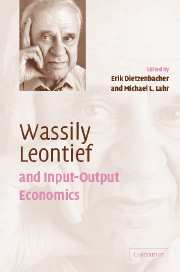Book contents
- Frontmatter
- Contents
- List of contributors
- List of figures
- List of tables
- Preface
- Part I Reflections on input-output economics
- 1 A portrait of the master as a young man
- 2 Leontief's “magnificent machine” and other contributions to applied economics
- 3 Leontief and the future of the world economy
- 4 International trade: evolution in the thought and analysis of Wassily Leontief
- 5 Leontief's input-output table and the French Development Plan
- 6 Leontief and dynamic regional models
- 7 Experiences with input-output and isomorphic analytical tools in spatial economics
- 8 Leontief and Schumpeter: a joint heritage with surprises
- 9 Some highlights in the life of Wassily Leontief – an interview with Estelle and Wassily Leontief
- Part II Perspectives of input-output economics
- Subject index
- Author index
5 - Leontief's input-output table and the French Development Plan
Published online by Cambridge University Press: 22 September 2009
- Frontmatter
- Contents
- List of contributors
- List of figures
- List of tables
- Preface
- Part I Reflections on input-output economics
- 1 A portrait of the master as a young man
- 2 Leontief's “magnificent machine” and other contributions to applied economics
- 3 Leontief and the future of the world economy
- 4 International trade: evolution in the thought and analysis of Wassily Leontief
- 5 Leontief's input-output table and the French Development Plan
- 6 Leontief and dynamic regional models
- 7 Experiences with input-output and isomorphic analytical tools in spatial economics
- 8 Leontief and Schumpeter: a joint heritage with surprises
- 9 Some highlights in the life of Wassily Leontief – an interview with Estelle and Wassily Leontief
- Part II Perspectives of input-output economics
- Subject index
- Author index
Summary
French problems at the end of World War II
In 1957 I was in charge of the application of Leontief's input-output table during the elaboration of France's third Development Plan. In retrospect, it appears this was the first time that his table had been used in the economic planning of an industrialized country. We analyzed the whole technological and economic situation in France with Leontief's table. We also used it to check if resource availability constrained the French economy's ability to meet its objectives. So, by experience, we learned input-output's advantages and drawbacks in this setting. In order to understand the reasons why Leontief's concept had been called into service, it is necessary to recall the French economic and political situation at the time.
Immediately after the end of World War II the French government faced an austere situation. First, it had an economy to restore – most factories not destroyed by the war were obsolete. This is because most of the then modern equipment in occupied France had been removed to Germany during the war. Moreover, the French population as a whole, including corporate managers, seems to have been generally satisfied with the nation's quasi-stagnant economy during the twenty-five years of the inter-war period and did not seek improvement. Perhaps worst of all, the nation had been dangerously divided, both socially and politically, since some citizens had collaborated with the occupying forces while others had actively resisted those forces.
Information
- Type
- Chapter
- Information
- Wassily Leontief and Input-Output Economics , pp. 65 - 89Publisher: Cambridge University PressPrint publication year: 2004
Accessibility standard: Unknown
Why this information is here
This section outlines the accessibility features of this content - including support for screen readers, full keyboard navigation and high-contrast display options. This may not be relevant for you.Accessibility Information
- 3
- Cited by
